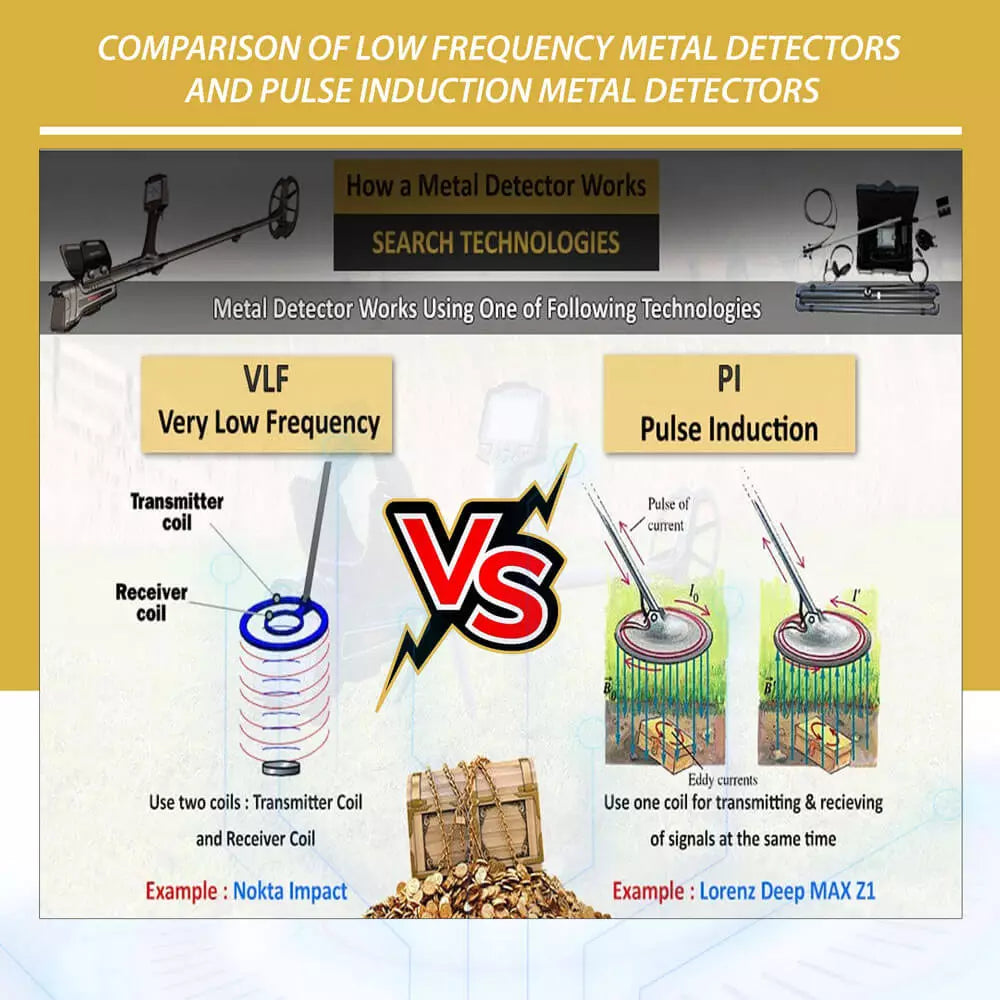Whats the Difference Between Pulse Induction and VLF Metal Detectors?
This is a question I am often asked by new customers who are unfamiliar with metal detector technology, and by far the most important one when choosing your first or next metal detector.
Metal detectors are widely used in various industries, from treasure hunting, gold prospecting and archaeological surveys to security screening at airports. Two commonly employed technologies for metal detection are Pulse Induction (PI) and Very Low Frequency (VLF) detectors.
Which of these two technologies is going to suit you best will depend tremendously on your preferred metal detecting style, conditions you expect to encounter, budget, and of course what you want to find.
While it is true that both VLF and Pulse Induction machines are metal detectors, and that in theory they can both detect gold, it is critical to understand the strengths and weaknesses of each technology if you wish to have the most success in finding your desired targets.
Induction Metal Detectors: Commonly Referred to as GOLD Detectors
Pulse Induction metal detectors operate by generating short and powerful pulses of current through a coil of wire. These pulses create a magnetic field that quickly collapses. As the magnetic field collapses, any nearby metallic objects will generate their own magnetic fields in response. The detector then measures the duration and intensity of the magnetic field generated by the metal object.
Key Characteristics and Advantages of Pulse Induction Detectors:
- Depth: PI detectors are known for their superior depth capabilities, making them suitable for searching in highly mineralized soils, underwater, and for locating deeply buried objects. Their ability to ignore the mineral content of the soil allows for greater detection depths compared to VLF detectors.
- Discrimination: PI detectors typically lack advanced discrimination features and struggle to distinguish between different types of metals. They tend to respond to all metal targets, which can be advantageous in some situations where you don't want to miss any potential finds.
- Stability: PI detectors are generally more stable in highly mineralized environments where VLF detectors may experience false signals due to the mineral content in the soil.
Very Low Frequency metal detectors operate by transmitting a continuous sine wave signal into the ground through the coil. When the transmitted signal encounters a metallic object, it creates eddy currents within the metal, which in turn generate a magnetic field. This magnetic field disrupts the frequency of the detector's coil, resulting in an audible response.
Key Characteristics and Advantages of VLF Detectors:
- Target Identification: VLF detectors offer advanced discrimination features, allowing users to identify and discriminate between different types of metals. This feature is useful in scenarios where you want to filter out unwanted objects, such as nails or aluminium foil, and focus on valuable targets like gold or coins.
- Sensitivity: VLF detectors are generally more sensitive to small and shallow targets, making them suitable for tasks such as coin shooting or relic hunting in less mineralized soils.
- Ground Balance: VLF detectors often have manual or automatic ground balance settings, allowing users to adjust the detector's sensitivity to mineralization. This feature helps in reducing false signals caused by mineral content in the soil.
Things to Note Between the Two:
1. Weight: The technology in Pulse Induction machines tends to be much heavier and bulkier than VLF machines. This is something important to take into consideration, especially for individuals with physical limitations and diminished stamina.
2. Price: Pulse Induction machines are costly to develop and involve much more complex hardware. In turn, they often cost several times more than a VLF machine, with the entry level P.I. machine, for most brands, starting at 3000 to 4000 dollars vs 300 to 1700 dollars for a VLF detector.
Conclusion: Deciding between a PI or VLF metal detector depends on various factors such as the intended use, search environment, target type, and personal preferences. If you prioritize depth and stability in highly mineralized areas or underwater, a PI detector may be more suitable. On the other hand, if you require target identification capabilities,sensitivity to small and shallow targets, and plan to search in less mineralized soils, a VLF detector may be the better choice.
Give us a call today and let us answer the questions you will inevitably have about which model to choose. We understand that cost is always a factor when considering a purchase and excel at finding the right machine for your needs without breaking the bank.
Thanks for reading
Cheers,
Heritage Gold Rush
